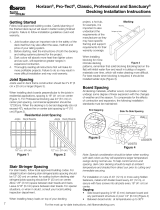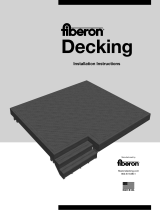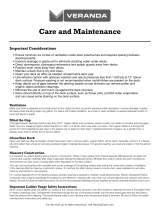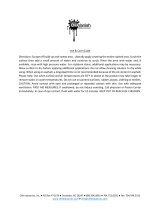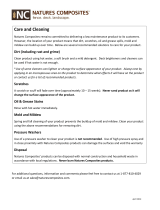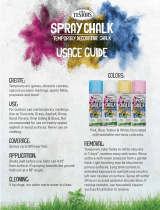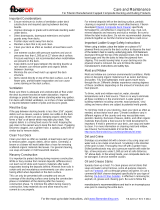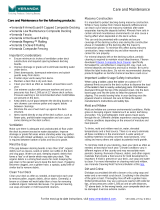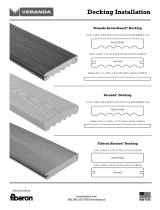Page is loading ...

Care and Maintenance
For Fiberon Manufactured Capped Composite Decking and Railing Products
For the most up-to-date instructions, visit fiberondecking.com.
FIB-0207-LIT REV I 915
Important Considerations
• Ensure a minimum of 1.5 inches (4 cm) required
ventilation under deck and required spacing between
decking boards. See ventilation requirements below.
• Improve drainage or grade soil to eliminate standing water
under decks.
• Direct downspouts, downspout extensions and splash
guards away from decks.
• Position dryer vents away from decks.
• Maintain a deck that is dry and clean.
• Clean your deck as often as needed, at least twice each
year.
• Use extreme caution with pressure washers and use at
pressures less than 3,000 psi (20684.3 kPa) at 10 inches
(25 cm) above deck surface. Pressure washing is not
recommended when mold/mildew are present on the deck.
• Keep debris out of gaps between the decking boards so
rain showers can remove pollen and organic debris
between cleanings.
• Minimize wet mulch up against the deck structure.
• Items stored directly on top of the deck surface, such as
flower pots, prohibit water evaporation and can cause
some staining on the deck surface.
Ventilation
Make sure there is adequate and unobstructed air flow under
50% of the deck. Allow a minimum of 1.5 inches (4 cm)
between bottom of joist and the ground. Water must be able to
flow away from under the deck. Improve drainage or grade flat
areas where standing water may gather. Do not install decking
directly to an existing or solid surface.
Sleeper Installation
Minimum joist height is 1.5 inches (4 cm), installed level, in
direction of water runoff and directly to a solid sub-structure.
Create adequate ventilation for the deck by widening side-to-
side spacing between boards to ¼ inch (6 cm) with a maximum
of 3/8 inch (9.5 mm) gap. The deck design must allow
unrestricted air flow under the deck at the open joist ends for
ventilation and drainage.
Mind the Gap
If the gap between decking boards is less than 3/16 inch (4.8
mm), organic debris such as leaves, seeds or pollen can settle
on the deck and clog gaps. Water can pool, steeping organic
debris that forms a “tea” or tannin which may stain your deck.
This organic debris is a strong food source for mold. Keeping
the gap clean is the easiest way to keep the deck clean. If
gapping becomes clogged, use a garden hose, a spatula, putty
knife or similar tool to remove debris.
Clean Your Deck
Clean your deck as often as needed, at least twice each year
to remove pollen, organic debris, dirt or stains. Generally, a
broom or a blower will work better than a hose for removing
scattered organic materials like leaves. For general cleaning,
use soap and water or mild household cleaners.
Construction Chalk
Colored chalk, used in construction for marking straight lines
prior to cutting, is permanent on most surfaces. Contact the
manufacturer of the specific brand and color of chalk for a
cleaning solution that may prove effective. The best advice is
to avoid colored chalk, using workable alternatives such as
white chalk or baby powder.
Masonry Construction
It is important to protect decking during masonry construction.
White or hazy residue from mineral deposits (efflorescence)
can leach out of stone and masonry materials after water
evaporates leaving the deposits behind. Minerals from soils in
certain arid and mountainous environments can also cause a
hazing affect when deposited on the deck surface. This can
only be prevented with complete and secure coverage of the
decking surface area during the construction phase or
installation of the decking after the masonry construction
phase. To minimize this affect during masonry construction,
keep materials dry and allow masonry and cement to cure
properly.
For mineral deposits left on the decking surface, periodic
cleaning is required to maintain visual attractiveness. Fiberon
developed Fiberon Composite Deck Cleaner specifically
formulated for, and effective in cleaning dirt, clay, mud, soil,
mineral deposits and masonry and stucco residue. Use the
Fiberon Composite Deck Cleaner with a brass bristle brush to
clean, repeating the process as needed. Be sure to follow the
label instructions. Do not mix recommended cleaning products
together as harmful chemical reactions could occur.
Dirt and Grime
Dislodge accumulated dirt with a broom or by using soap and
water and a non-metal scrub brush. Thoroughly rinse off with a
garden hose. Skilled professionals may use a pressure washer
with wide fan tips, at low pressures under 3,000 psi (20684.3
kPa) and at safe distances, 10 inches (25 cm) above deck. In
the wrong hands, your composite deck can be damaged.
Exercise extreme caution.
Oil and Grease Stains
Speedy clean-up is best. To clean grease and oil stains that
soap and water cannot remove, some all-purpose cleaners,
such as Fantastik, will cut through grease and grime. Or use a
commercial deck cleaner designed specifically for your type of
decking.
De-Solv-It Citrus Solution is effective in removing tar,
asphalt, oil, grease and chewing gum. Be sure to follow the
manufacturer’s recommendations and test in an inconspicuous
area prior to cleaning the entire deck.
Mold and Mildew
Mold and mildew are common environmental conditions. Molds
grow on decaying organic material such as wood, leaf decay
and pollen. Tiny and lightweight, mold spores travel easily
through the air. Different climates experience varying degrees
of these conditions depending on the amount of moisture and
heat present.
To thrive, mold and mildew need air, water, elevated
temperatures and a food source. There is no way to eliminate
all these conditions in the environment. A wide variety of
building materials including concrete, wood products, vinyl
siding and many others are subject to potential mold growth.
To minimize mold on your decking, clean your deck as often as

Care and Maintenance
For Fiberon Manufactured Capped Composite Decking and Railing Products
For the most up-to-date instructions, visit fiberondecking.com.
FIB-0207-LIT REV I 915
needed, at least twice each year. Climate conditions vary in
different regions of the country and may necessitate more
periodic cleaning. Removal of leaves, debris, and other organic
materials that provide a food source for mold development is
important. If mold is present on your deck, there are many
commercial products available for cleaning mold. We
recommend the following commercial cleaners. For best
results, be sure to follow the manufacturer’s instructions and
use cleaners within their stated shelf life. Do not mix
recommended cleaning products together as harmful chemical
reactions could occur. Never mix bleach and acids.
Collier Manufacturing 30-Seconds® Outdoor Cleaner and 30-
Seconds® Spray & Walk Away are heavy duty, mildly alkaline
chlorinated mold and mildew removers/cleaners that are
biodegradable once rinsed into the soil. Both have been tested
and perform very well in removing mold and mildew and
retarding its return.
For more information on cleaning mold and mildew, see
Fiberon Technical Bulletin # 13 at this link,
fiberondecking.com/resources/literature.
Salt and Calcium Chloride
Buildup of salt and calcium chloride from snow and ice removal
is easily removed with enough water and perhaps a light scrub.
Use a garden hose or sprayer. If using a pressure washer, use
at low pressures under 3,000 psi (20684.3 kPa) and at safe
distances, 10 inches (25 cm) above deck, to avoid damaging
your deck. Never use metal shovels or sharp-edged tools to
remove snow and ice on the surface of any Fiberon decking
product.
Static
Dry or windy environments may create a temporary condition
of static electricity, which will vary depending on climate and
site conditions. Heat pumps and dryer vents that are close to,
or pointed toward the decking material, can also generate
static electricity on the deck.
Rubber Mats
Welcome mats or grill mats with a rubber, vinyl or latex backing
can mark your deck. The marks can be removed, but to avoid
them, use high quality polypropylene or colorfast woven rugs
only.
Important Ladder Usage Safety Instructions
When using a ladder, place the ladder on a piece of ¾ inch
plywood firmly secured to the deck surface to disperse the load
of the ladder’s feet to nearby underlying joists. Drill fasteners
downward through the top of the plywood sheet, into the deck
board gaps and into the joists to keep the plywood from
slipping. This avoids leaving holes in your decking once the
plywood sheet is removed. Be sure to follow the ladder
manufacturer’s instructions and safety tips.
Fire and Unusual Heat Sources
Composite decking will retain heat when exposed to direct or
reflective sunlight. Exercise caution if walking barefoot as
footwear may be required. Fire and unusual sources of heat
and heat build-up can possibly damage Fiberon decking
surfaces. Examples would include fire, reflected light from
different types of glass (ex. low-e glass), fire features and
under-deck waterproofing installations that do not provide the
1.5 inches (4 cm) of unobstructed net free ventilation.
•Low-E Glass/Reflected Heat
Low-emissivity glass is designed to prevent heat gain inside
the house by reflecting sunlight outward. This reflective
property can result in excessive heat build-up on the surface
of Fiberon decking. The properties that Low-E glass employs
to prevent passive heat gain within a structure can result in
unusual heat build-up on exterior surfaces.
When sunlight is reflected and concentrated, it can harm a
range of building materials that include doors, windows,
siding, trim and decking. Damage caused to these products
can include melting, sagging, warping, discoloration,
increased expansion and contraction, and accelerated
weathering.
If you have questions on how to reduce this risk, contact the
manufacturer of the product which contains the Low-E glass
for suggestions on how to reduce or eliminate the reflected
heat.
• Under-deck waterproofing systems
Under-deck waterproofing systems, properly installed, can
provide additional living or storage space. Improper
installations are those that restrict air flow and result in build-
up of heat and/or humidity which can result in unwanted
consequences. Contact the manufacturer of the specific
under-deck waterproofing system for installation instructions
to ensure the required 1.5 inches (4 cm) of unobstructed
ventilation is achieved for Fiberon decking. If already
installed, seek methods to achieve the ventilation
requirement.
• Fire Features/Fire Pits
Fire features and fire pits are increasingly popular in outdoor
living environments. Fire can damage many building
products, including Fiberon decking. Improperly installed fire
features and fire pits can cause damage to the surface of
Fiberon decking via direct exposure to the flame or
excessive radiated heat. Proper caution should be taken
when designing, installing and using these features to
ensure damage does not result.
Fiberon Paramount Decking
Recommended cleaners include Simple Green and Krud Kutter
Cleaner Degreaser. Follow the manufacturer’s instructions and
test in an inconspicuous area to make sure cleaner does not
harm the decking surface. Avoid the use of rubber, vinyl or
polypropylene products on Paramount Decking as a reaction
could occur resulting in discoloration under the product. Use
colorfast woven rugs only. Certain chemical ingredients in
products such as insect repellent and sunblock could cause a
reaction and result in a stain on the decking surface.
/

